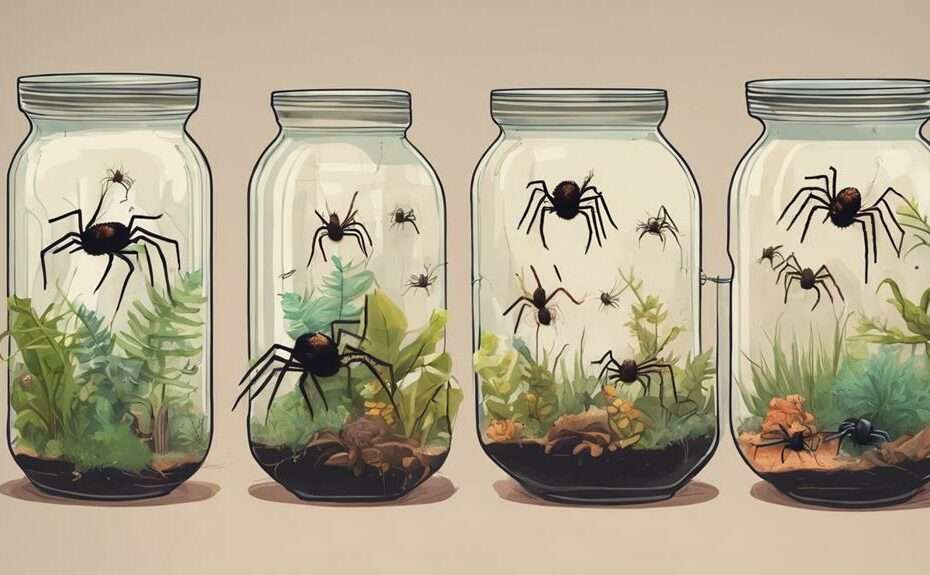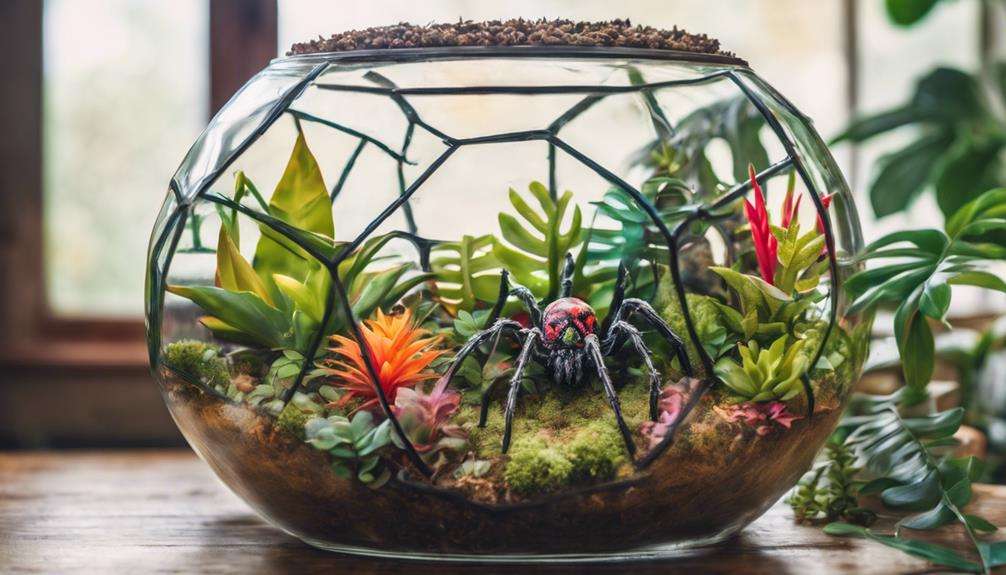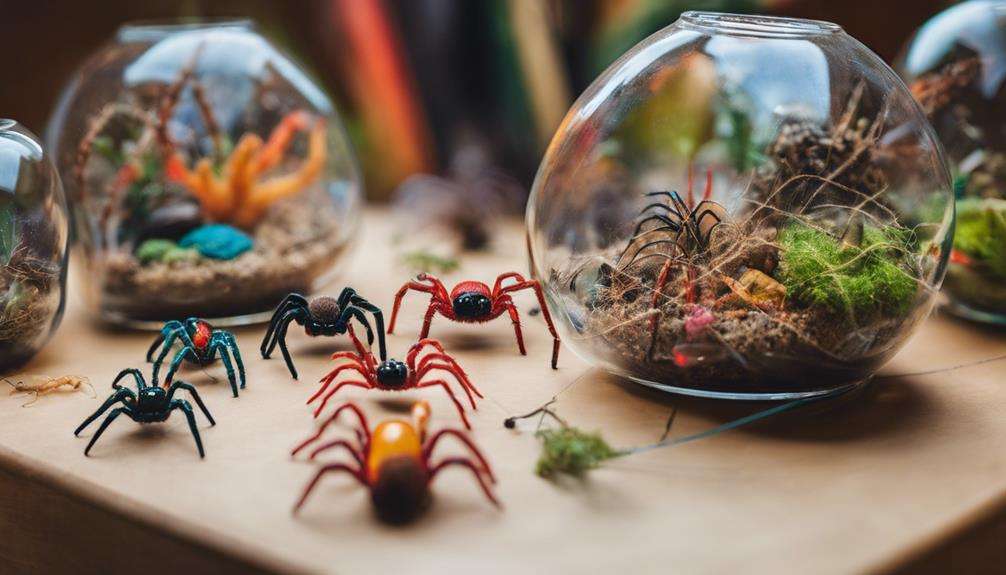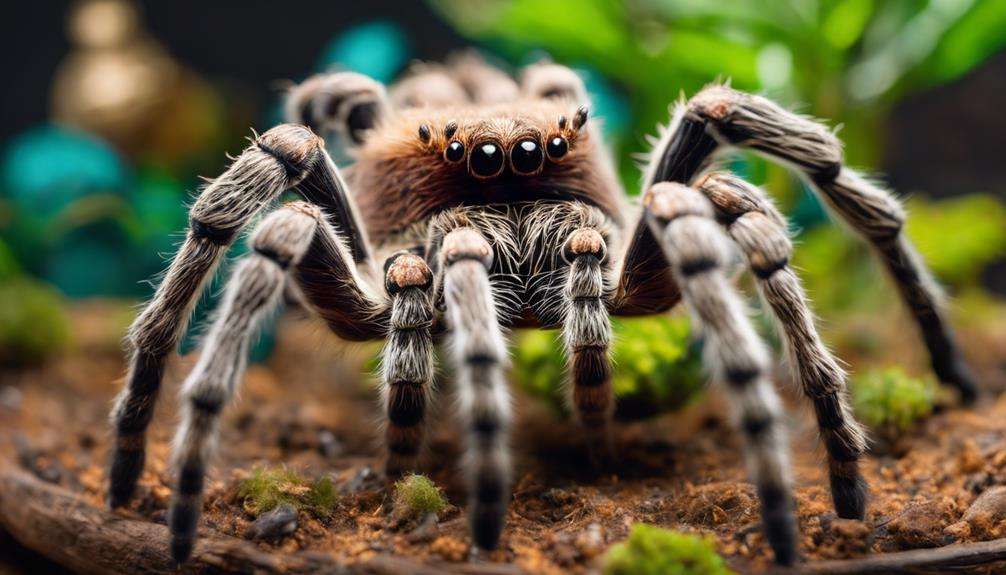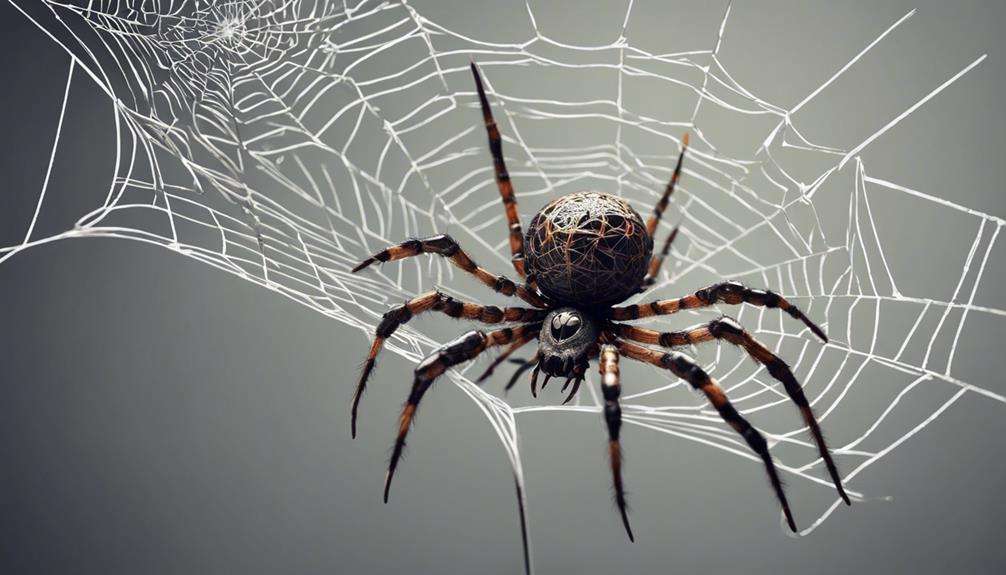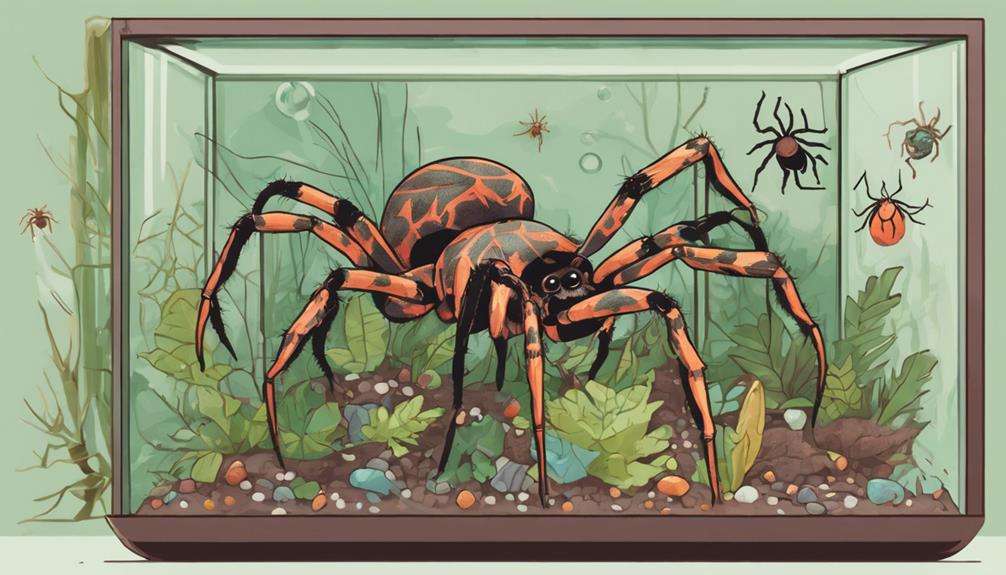As you commence on the intricate journey of breeding pet spiders at home, think of it as carefully weaving a delicate web of knowledge and patience.
Each step in this process requires precision and dedication to guarantee the well-being of your arachnid companions. From selecting compatible spider species to nurturing spiderlings to maturity, the path ahead holds valuable insights into the fascinating world of spider breeding.
Stay tuned to uncover essential tips that will guide you through this engaging endeavor with your eight-legged friends.
Key Takeaways
- Select compatible spider species based on temperament and space requirements for successful mating.
- Create an ideal breeding environment with proper temperature, humidity, and nutrition.
- Monitor mating behaviors closely for safety and successful fertilization.
- Care for egg sac and spiderlings meticulously for optimal hatching and growth.
Selecting Compatible Spider Species
When selecting compatible spider species for breeding, consider their temperament and space requirements to guarantee successful mating and cohabitation. It's important to match a male and female jumping spider for mating. Make sure the female is well-fed before introducing the male to prevent any aggressive behavior.
Once they've successfully mated, the female will lay eggs in an egg sac. To create a suitable environment for the female jumping spider, provide fake plastic plants for hiding spots and use a spray bottle to maintain humidity levels.
After the female lays her eggs, carefully monitor the egg sac until tiny spiders emerge. It's important to separate the male and female at this stage to prevent any potential harm to the offspring. By understanding the natural behaviors and requirements of each spider species, you can increase the chances of a successful breeding process. Consulting with experienced breeders or arachnologists can also provide valuable insights into selecting compatible spider species for breeding.
Creating the Ideal Breeding Environment
To create the ideal breeding environment for your pet spiders, make sure the terrarium is spacious with plenty of hiding spots and climbing structures. Maintain precise temperature and humidity levels, offer a diverse and nutritious diet, and closely monitor their behavior for signs of successful mating.
Temperature and Humidity
Maintain a temperature range of 70-85°F and humidity levels around 60-80% to create the ideal breeding environment for most pet spider species. Use a digital thermometer and hygrometer to monitor these conditions accurately.
Heating pads can help regulate temperature, while misting and ventilation aid in adjusting humidity levels. Ensuring these parameters are within the specified ranges is essential for the successful breeding of pet spiders at home.
Remember that consistent temperature and humidity play a significant role in supporting proper egg development and hatching. By paying close attention to these factors and making necessary adjustments, you can create a favorable environment for your pet spiders to thrive and reproduce.
Food and Water
In the ideal breeding environment for pet spiders, providing a varied diet of live insects such as crickets and mealworms for best nutrition is essential. Live insects offer the necessary nutrients that breeding spiders require for best health and development.
Additionally, make sure a water dish is always accessible to meet their hydration needs. Monitoring feeding habits is important to confirm that the spiders are consuming sufficient food. Adjust the feeding frequency according to the size of the spider and the prey to support proper growth.
Maintaining a clean habitat is paramount to prevent contamination and safeguard the health of breeding spiders. A well-balanced diet, access to water, and a hygienic environment are key factors in successfully breeding pet spiders at home.
Nesting and Mating
When preparing the breeding environment for pet spiders, make sure to provide a secluded nesting area with suitable substrate for the female spider to lay eggs. It's important to maintain ideal temperature and humidity levels to facilitate the mating process successfully.
Introduce the male spider to the female in a controlled setting to encourage natural mating behaviors. Monitor the mating process closely to guarantee safety and successful fertilization. After mating, promptly remove the male spider to prevent aggression or harm to the female.
Introducing and Monitoring Mating
To increase the likelihood of successful mating between pet spiders, make sure that both the male and female are adult individuals of the same species before introducing them.
When introducing spiders for mating, it's important to closely monitor the mating process. This can vary in duration, ranging from 5 minutes to over an hour. Look for specific mating behaviors and signs of successful pairing, such as intricate movements and interactions between the male and female.
Providing a well-fed environment is essential to prevent the female spider from potentially consuming the male post-mating. Understanding the timing for pairing is also important, typically occurring 1-2 weeks after the female's final molt, to enhance breeding success.
Handling Egg Sac Care
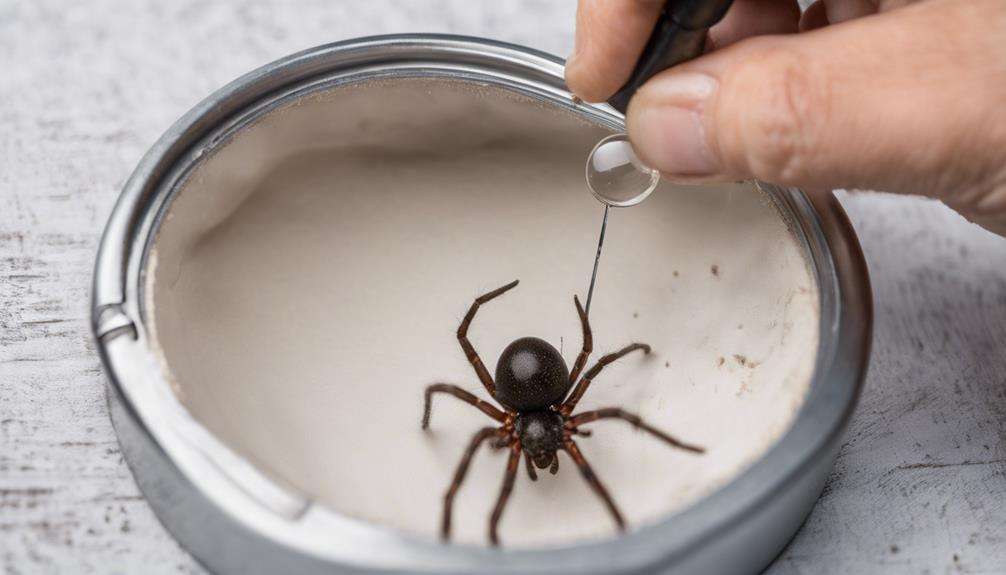
Female spiders meticulously construct silk egg sacs to safeguard and nourish their developing eggs. Proper care of the egg sac is vital for successful hatching and the health of the spiderlings.
To maintain ideal humidity levels, mist the egg sac lightly once a week, making sure that the moisture doesn't directly contact the eggs. Many breeders suggest leaving the egg sac with the female spider until hatching, as she can provide essential care. However, some breeders prefer to remove the mother spider after she naturally leaves the egg sac, believing this results in better survival rates for the spiderlings.
Monitoring the egg sac is essential during this time; any changes in color, texture, or signs of mold should be noted promptly. By carefully tending to the egg sac and keeping a close eye on its development, you can guarantee a successful hatching and provide the best care for the emerging spiderlings.
Nurturing Spiderlings to Maturity
Inspecting the development of spiderlings closely is imperative for ensuring their successful nurturing to maturity. After the female gets ready to lay her eggs, it's critical to remove the mother to prevent potential harm to the spiderlings.
Spiderlings should be housed together until they reach the 3rd or 4th instar stage to promote the best development. Providing small prey such as springtails or fruit flies is essential for feeding baby spiders and supporting their growth. Avoid feeding ants to spiderlings due to their toxicity, which can be harmful to the young spiders.
When handling spiderlings, care must be taken to prevent any injuries and ensure their well-being as they mature. Using 4 oz deli cups or small clear plastic containers for housing spiderlings creates a suitable environment for their growth and development.
Ensuring Long-Term Adult Health
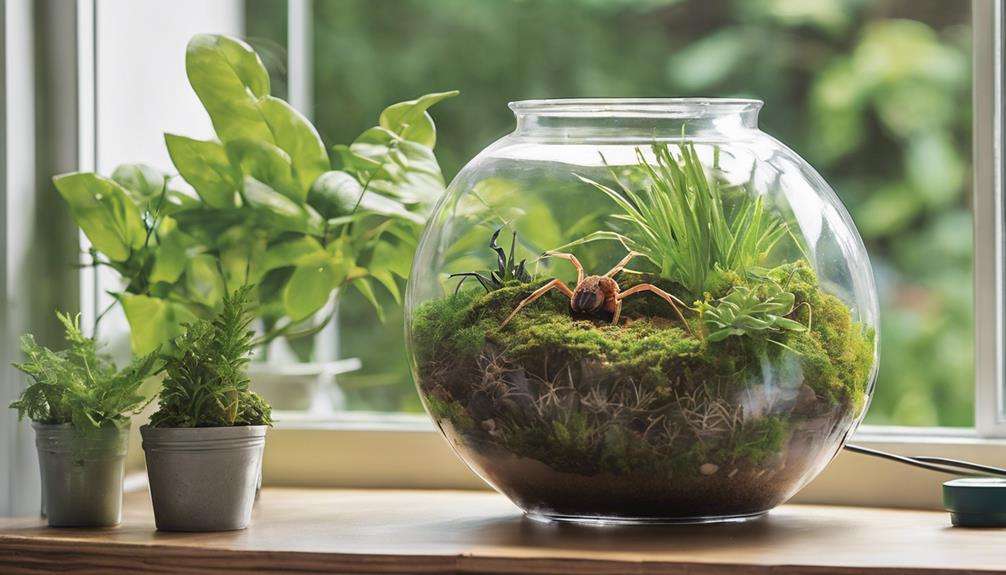
For best long-term health in adult spiders, regular monitoring of signs of molting is essential to gauge their growth and well-being accurately. Molting is a critical indicator of adult spider health and development status, as it signifies growth cycles and the need for potential dietary adjustments. Providing a varied diet is important to make sure adult spiders receive essential nutrients for ideal health.
Proper ventilation within the spider enclosure is necessary to prevent respiratory issues that could impact the long-term well-being of adult spiders. Maintaining suitable temperature and humidity levels is also important for supporting the overall health of adult spiders, as deviations from these parameters can lead to stress and health complications.
Regularly cleaning the spider habitat is important to prevent the buildup of mold or bacteria, which could pose risks to adult spider health. By attentively monitoring molting, offering a diverse diet, ensuring proper ventilation, and maintaining ideal environmental conditions, you can promote the long-term health and well-being of your adult spiders.
Frequently Asked Questions
How Do You Start Breeding Spiders?
To start breeding spiders, make sure you have a male and female of the same species. Monitor receptivity signs, create a suitable environment, supervise mating, and separate them after. Follow these steps for successful breeding.
Do Pet Spiders Recognize Their Owners?
When it comes to pet spiders recognizing their owners, it's important to understand their instincts and sensory responses. While they may display behavioral cues like hiding, spiders don't form social bonds or communicate recognition like mammals.
Do Spiders Need a Partner to Lay Eggs?
Spiders can lay eggs without a partner through solo reproduction. The egg-laying process involves storing sperm from mating or producing viable eggs without mating. Parental care, fertilization methods, mating rituals, and egg sac care influence breeding success and the reproductive cycle.
What Is the Easiest Spider to Have as a Pet?
The Chilean Rose Hair Tarantula stands out as the easiest spider to own. Their low-maintenance nature, calm temperament, and adaptability to various conditions make them ideal for beginner keepers. With proper care, they thrive.
Conclusion
Now that you have mastered the art of breeding pet spiders at home, remember to always stay curious and explore new theories and techniques.
By experimenting and observing the results, you can continue to improve your breeding practices and contribute to the fascinating world of arachnid husbandry.
Keep learning, keep growing, and most importantly, keep enjoying the rewarding journey of breeding pet spiders.
Happy breeding!
